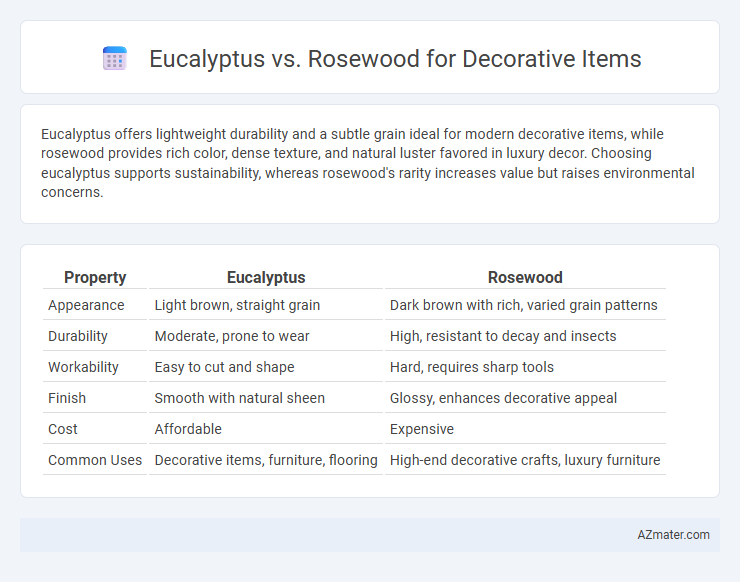Eucalyptus offers lightweight durability and a subtle grain ideal for modern decorative items, while rosewood provides rich color, dense texture, and natural luster favored in luxury decor. Choosing eucalyptus supports sustainability, whereas rosewood's rarity increases value but raises environmental concerns.
Table of Comparison
| Property | Eucalyptus | Rosewood |
|---|---|---|
| Appearance | Light brown, straight grain | Dark brown with rich, varied grain patterns |
| Durability | Moderate, prone to wear | High, resistant to decay and insects |
| Workability | Easy to cut and shape | Hard, requires sharp tools |
| Finish | Smooth with natural sheen | Glossy, enhances decorative appeal |
| Cost | Affordable | Expensive |
| Common Uses | Decorative items, furniture, flooring | High-end decorative crafts, luxury furniture |
Overview: Eucalyptus vs Rosewood
Eucalyptus offers a lightweight, durable option for decorative items, characterized by its pale, smooth grain and natural resistance to moisture, making it suitable for indoor and outdoor use. Rosewood, known for its rich, dark hues and dense, oily texture, provides a luxurious appearance and exceptional durability, often chosen for high-end decorative pieces and intricate carvings. Both woods differ significantly in cost, with rosewood generally being more expensive due to its rarity and aesthetic appeal, while eucalyptus remains more accessible and environmentally sustainable.
Botanical Characteristics and Origins
Eucalyptus wood originates from diverse species native to Australia, characterized by its dense, hard texture and distinct aromatic scent, commonly used in decorative items for its natural durability and smooth grain. Rosewood, primarily derived from Dalbergia species found in tropical regions such as India and Brazil, exhibits rich, dark hues with intricate grain patterns prized for luxury furniture and intricate carvings. Botanical distinctions include eucalyptus belonging to the Myrtaceae family with simple, oil-filled leaves, while rosewood is part of the Fabaceae family, noted for compound leaves and fragrant heartwood essential for high-end decorative craftsmanship.
Appearance and Grain Patterns
Eucalyptus wood features a smooth texture with subtle, wavy grain patterns and a light to medium brown hue that enhances the natural warmth of decorative items. Rosewood is renowned for its rich, dark reddish-brown color with striking, intricate grain patterns that include swirls and contrasting streaks, offering a luxurious and dramatic appearance. The choice between eucalyptus and rosewood for decorative items depends on whether a lighter, understated elegance or a bold, richly textured finish is desired.
Color Variations and Aesthetic Appeal
Eucalyptus wood offers a light to medium brown color with subtle greenish or grayish hues, providing a natural, rustic aesthetic ideal for modern and minimalist decorative items. Rosewood displays rich, deep reddish-brown tones with dramatic dark veins, creating a luxurious and elegant look perfect for statement pieces and intricate carvings. The distinct color variations in eucalyptus enhance casual decor styles, whereas rosewood's striking grain patterns elevate formal and classic interiors.
Durability and Hardness Comparison
Eucalyptus wood offers moderate durability with a Janka hardness rating around 1,150, making it suitable for decorative items that require some resistance to wear and tear. Rosewood, known for its superior hardness and density, typically rates between 1,290 and 2,440 on the Janka scale, providing exceptional durability and longevity for intricate and high-quality decorative pieces. When choosing between the two, rosewood's higher hardness ensures better resistance to dents and scratches, while eucalyptus provides a more affordable and sustainably sourced option with decent durability.
Workability and Crafting Suitability
Eucalyptus offers excellent workability due to its fine grain and moderate hardness, making it ideal for detailed carving and smooth finishes in decorative items. In contrast, Rosewood's dense, oily texture provides a luxurious appearance and durability but requires sharper tools and more effort during crafting. Both woods suit decorative purposes, but Eucalyptus is preferred for ease of shaping, while Rosewood excels in high-end, intricate designs.
Scent Profiles and Sensory Impact
Eucalyptus offers a fresh, invigorating aroma with menthol and camphor notes, creating a calming and purifying sensory experience ideal for decorative items. Rosewood emits a sweet, woody fragrance with subtle floral undertones, contributing a warm, luxurious ambiance that enhances interior decor. Choosing between eucalyptus and rosewood depends on whether a crisp, revitalizing scent or a rich, elegant aroma is preferred for the decorative item's sensory impact.
Sustainability and Environmental Impact
Eucalyptus is a fast-growing, renewable resource that requires less water and pesticides, making it a more sustainable option for decorative items compared to rosewood, which grows slowly and is often harvested unsustainably, contributing to deforestation. Rosewood is listed under CITES Appendix II due to its overexploitation, leading to stricter trade regulations and higher environmental costs. Choosing eucalyptus for decorative items supports eco-friendly practices and reduces the carbon footprint associated with timber harvesting.
Price and Market Availability
Eucalyptus offers an affordable option for decorative items, with prices generally lower than rosewood due to its faster growth rate and greater abundance. Rosewood, known for its rich color and durability, commands a higher price and is less readily available because of strict export regulations and limited supply. The market favors eucalyptus for budget-friendly decor, while rosewood remains a premium choice sought after for luxury craftsmanship.
Best Uses in Decorative Item Design
Eucalyptus wood features a light, smooth grain ideal for modern decorative items such as vases, picture frames, and minimalist sculptures, offering a natural, airy aesthetic. Rosewood, known for its dense grain and rich, reddish-brown hues, is best suited for intricate carvings, inlays, and high-end decorative boxes or furniture accents that demand durability and luxury. Choosing eucalyptus emphasizes eco-friendly, lightweight designs, while rosewood elevates luxury appeal with its striking color and resilience in decorative craftsmanship.

Infographic: Eucalyptus vs Rosewood for Decorative Item
 azmater.com
azmater.com